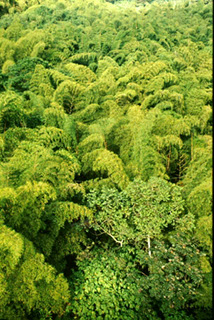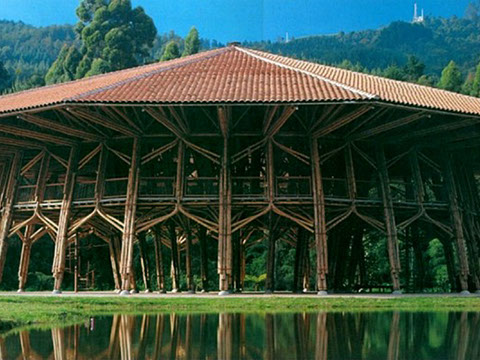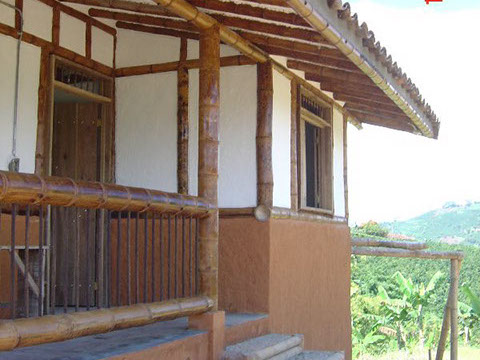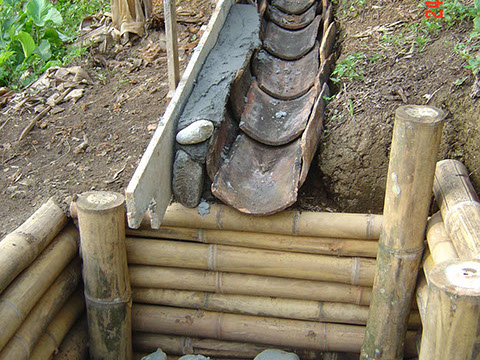ZERI
Zero Emissions Research and Initiatives
BAMBOO





© Gunter Pauli
The Global ZERI Network participated in the World Expo in Germany in 2000, designing and building a bamboo structure that has become a landmark in sustainable architecture. The pavilion was designed by Simon Velez of Colombia and underwent a series of scientific tests in collaboration with several academic institutions: University of Braunschwieg, University of Stuttgart, and Science University of Bremen. The building was erected first in Colombia, then in Hannover and received 6.4 million visitors during the 5 month Expo.
ZERI did not embark on the construction of this magnificent building just for the sake of building it. It was a major effort to change the image of bamboo; the majority of the estimated one billion people who use this readily available building material consider it to be a symbol of poverty. The intention of this project was to create a unique structure that would instill pride in and stimulate the use of this abundant, fast-growing construction material. After its remarkable presence at the World Expo in Germany, the pavilion was reconstructed in Manizales, Colombia where it now serves as a symbol of pride for the surrounding coffee farmers.
The coffee region is known for its cold nights and hot days. The airflow of the farmhouse is designed with all of the ingenuity and simplicity of our friend, the termite. Air tunnels that mimic termite hills are dug into the earth to allow for efficient airflow. During the hottest parts of the day, cool and dry air flows into the building. The air flows through the tunnels constructed below the house, then cools down and condenses. As the hot air is leaving the house, fresh air moves in thanks to the vacuum that is created.
While bamboo is considered a symbol of poverty, a flush toilet is considered a symbol of progress. However, the farms are not connected to a sewage system, with expensive drinking water being used to flush the toilets and send the black-water into the local creek. ZERI has introduced the toilet design of ecological architect Anders Nyquist of Sweden, a simple yet sophisticated device that respects nature's wisdom in keeping solids and liquids separate from each other. After about two years of curing the solids are used as valuable compost on the farmland. This toilet reduces the daily water needs on the farm from 100 liters/day to 10 liters/day, as 80 liters/day were used to flush.
When the farmer only produced coffee, the only crop he could sell is coffee. Based on the zero emissions concept, the ZERI model farm known as La Miñoca in Colombia generates 5 products on the basis of the ecosystem which made his coffee farm so successful in the past: coffee remains the core crop, six different herbal and caffeine free teas, three types of mushrooms, dehydrated bananas and bamboo products.
The coffee region is known for its cold nights and hot days. The airflow of the farmhouse is designed with all of the ingenuity and simplicity of our friend, the termite. Air tunnels that mimic termite hills are dug into the earth to allow for efficient airflow. During the hottest parts of the day, cool and dry air flows into the building. The air flows through the tunnels constructed below the house, then cools down and condenses. As the hot air is leaving the house, fresh air moves in thanks to the vacuum that is created.
While bamboo is considered a symbol of poverty, a flush toilet is considered a symbol of progress. However, the farms are not connected to a sewage system, with expensive drinking water being used to flush the toilets and send the blackwater into the local creek. ZERI has introduced the toilet design of ecological architect Anders Nyquist of Sweden, a simple yet sophisticated device that respects nature's wisdom in keeping solids and liquids separate from each other. After about two years of curing the solids are used as valuable compost on the farmland. This toilet reduces the daily water needs on the farm from 100 liters/day to 10 liters/day, as 80 liters/day were used to flush.
When the farmer only produced coffee, the only crop he could sell is coffee. Based on the zero emissions concept, the ZERI model farm known as La Mi¤oca in Colombia generates 5 products on the basis of the ecosystem which made his coffee farm so successful in the past: coffee remains the core crop, six different herbal and caffeine free teas, three types of mushrooms, dehydrated bananas and bamboo products.
